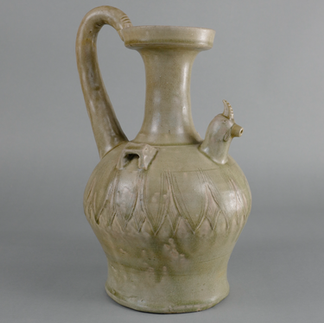展覽筆記 vol.16 南北朝雞首壺 A Green Glaze Chicken-Head Ewer, Lam's Gallery.
- SACA

- Apr 1, 2024
- 6 min read

雞是人類最早馴化的動物之一,與人們的生活息息相關。雞的品性既馴良溫順又驍勇好鬥,歷史上人們總結了雞的特性,在雞的身上寄託了人類對於自身優秀品質的追求。
西漢較早時期的著作《韓詩外傳》中有所謂雞有「五德」的記載,是說「頭戴冠者,文也;足搏距者,武也;敵在前敢鬥者,勇也;見食相呼者,仁也;守夜不失時者,信也。」認為雞是具備了「文,武,勇,仁,信」這樣「五德」的佳禽,是人類值得信賴的好夥伴。
展覽筆記 vol.16 南北朝 雞首壺

上海博物館 藏

浙江省博物館 藏
從考古及歷代文物遺存的角度,也可以看出人們與雞的關係向來就極為密切。雞的飼養有著悠久的歷史。河北武安縣磁山村一處距今約8000多年的新石器時代遺址就出土過許多的雞骨。屬於仰韶文化的廟底溝遺址也發現有家禽雞的骨頭。
再以後,山西的東漢的畫像石墓中也出現過雞首人身的畫象,被研究者認為是雞首人身的守護神形象。西晉開始,在中國古代的陶瓷史上出現了一種流傳時間比較長,造型古樸簡潔的容器,叫作雞首壺。這種壺名字的由來,得自於在它的肩部有一個塑造成雞首形象的流口。這個雞首流在早期,僅僅起到一個裝飾作用,到東晉以後,雞首與壺腹相通,成為可以倒水的流。雞首壺流行在兩晉南北朝時期,「雞」與「吉」同音,反映了大動亂時期,人民對安定生活的嚮往。上海博物館收藏的南朝的青釉刻花蓮瓣紋雞首壺,釉色清雅,造型挺拔,器身上裝飾著反映佛教信仰的蓮瓣紋,整體器物和諧優美,體現了南朝時江南地區的瓷器製造工藝的成就。在工藝和繪畫作品中,雞也一直是人們樂於表現的題材。
明代成化年間的雞缸杯向稱珍罕,在清代就屢為宮廷仿作。玉製品中天雞瓶、天雞玉飾也是經常被製作的題材。織繡、繪畫等藝術品色彩豐富,最能精細入微地體現雞的冠羽之華美,佳作紛呈。近代以來我國著名畫家齊白石與徐悲鴻在以雞入畫的藝術創作中也取得了非凡的成績。白石老人畫雞雛,生動可愛,彷彿絨絨的小雞破殼而出,踏泥而來,洋溢著濃濃的生機與情趣。而悲鴻除了畫馬入神外,一隻昂首挺胸的紅冠大公雞正在春晨報曉,提醒著人們珍惜大好時光,積蓄幹勁,積極投入生活的意境。
無獨有偶,雞在各種外國文物中也是深受寵愛的對象,它們羽翼華美和憨態可掬的形象在種類繁多的藝術品中頻頻出現,帶給人們以美和愉悅的享受。上海博物館收藏的外國文物里,就有一批這樣的佳作,與館藏的本國作品相比,情趣迥異而生動優美不遑多讓。
千百年來,雞以它忠實守信,親近人類的特點而受到人們的喜愛。





The relationship between people and chickens has always been a close one, as can be seen from archaeological and archaeological remains. Chickens have a long history of breeding. Many chicken bones have been unearthed at a Neolithic site in the village of Jieshan, Wuan County, Hebei Province, which is more than 8,000 years old. Bones of domesticated chickens were also found at the site of Miaodigou, which belongs to the Yangshao culture. Later, in the Eastern Han Dynasty in Shanxi, there were paintings of chickens with their heads on stone tombs, which were regarded by researchers as guardian deities with chicken heads. Beginning in the Western Jin dynasty, a relatively long-lived and simple vessel called the chicken-headed bottle appeared in the history of ancient Chinese ceramics. The name derives from the fact that the bottle has a spout molded into the shape of a chicken's head at the shoulder. In the early period, this stream was merely decorative, but after the Eastern Jin dynasty, it was connected to the belly of the bottle and became a stream from which water could be poured. The popularity of the cock's head during the Northern and Southern Dynasties, and the fact that the word 'cock' is used in the same way as 'auspicious', reflect the people's desire for a stable life during a period of great turmoil. Shanghai Museum collection of the Southern Dynasties of the blue glaze carved lotus petal pattern chicken head bottle, glaze color elegant, upright shape, body decorated with reflecting the Buddhist beliefs of the lotus petal pattern, the overall harmony and grace of the object, reflecting the Southern Dynasties of the Jiangnan region of the porcelain manufacturing industry achievements. In crafts and paintings, chickens have always been a popular subject. In the Ming Dynasty, the Chenghua period of the chicken tankard cup to be known as rare, in the Qing Dynasty, repeatedly for the court imitation. Jade vases and jade ornaments were also frequently made with chickens. Embroidery, paintings and other works of art are rich in color and can best reflect the beauty of the chicken's crown and feathers in minute detail, resulting in a wide range of masterpieces. In recent times, our famous painters Qi Baishi and Xu Beihong have made extraordinary achievements in the art of painting chickens. Bai Shi painted chicken chicks, lively and lovely, as if the fluffy chick broke out of its shell and stepped on the mud, overflowing with rich vitality and interest. In addition to the paintings of Beihong horse, a red-crowned cockerel with its head held high is reporting the dawn in the spring morning, reminding people to cherish the good times, to build up energy, and to actively engage in the mood of life.
Uniquely, chickens are also favorite objects in a variety of foreign cultural relics, and their gorgeous feathers and naive image appear frequently in a wide range of artworks, bringing people the enjoyment of beauty and pleasure. In the collection of foreign cultural relics in the Shanghai Museum, there are a number of such masterpieces, compared with the collection of local works, the interest is very different and vivid and beautiful.
For thousands of years, chickens have been loved by people for its faithfulness and closeness to human beings.
閱讀寶榜發布的《松心蒼翠》文章:https://mp.weixin.qq.com/s/Y9LeomHo5p9MYKksUtEqbw
閱讀SACA學會發佈的《 北齊之光》常盤山文庫文章:
Download the Exhibition Catalogue:

松心蒼翠
松心閣很高興推出第二期主題線上展覧「松心蒼翠」。南北朝时期(439-589 年)形勢混亂動盪、災難連綿,不但考驗了人性的堅韌,也催生了頂級藝術的誕生。
南北朝的美是不同文化交融、碰撞、綻放的美。當中佛教的興起令與其相關的圖案在中國流行起来,象徵佛教的蓮花常被用作器皿的形状和图案;而南方的青瓷也廣被北方接受。在中国陶瓷史上,青瓷釉料的生产越来越广泛,這是一個中國藝術史上十分關鍵,承上啟下的時代。
這時代的中國,不同材質的藝術品如一場絢爛的煙花,其深度、廣度奠定了南北朝在中國藝術史中的不可撼動的地位。匠人們在一次次的不確定性中以發自內心的真切之美作為抵抗,而這種默默無言,源自人性堅韌的精神力量,浩瀚磅礴,穿透時間,撼動心靈。
這無疑是一個值得被研究學習的時代,松心閣希望透過是次「松心蒼翠南北朝特別展覽」與大家一起分享這時代的不同文物,我們誠邀您通過以下網址與我們一起踏上南北朝之旅:https://lams-gallery.com/ (复制黏贴至浏览器,或者点击文章底部左下角“阅读原文”。
— 松心閣

Eternal Dynasties
a Special Exhibition of Northern & Southern Dynasties
The North and South Dynasties (439-589) were a period of chaos and disaster, which not only tested the resilience of human nature, but also gave rise to the birth of top-notch art.
The beauty of the Northern and Southern Dynasties is the beauty of different cultures that blossomed through the fusion and collision of several cultures. The rise of Buddhism led to the popularization of motifs related to Buddhism in China, with the lotus flower, a symbol of Buddhism, often used as the shape and motif of vessels of that period; during which time celadon from the south was also widely accepted in the north. The production of celadon glazes became increasingly widespread in Chinese ceramics, and this was a pivotal era in the history of Chinese art, a time of transition from the past to the present.
The depth and breadth of the fireworks display of different materials in China during this era established the North and South Dynasties as an unassailable part of Chinese art history. Craftsmen resisted the uncertainty time and again with the true beauty of their hearts, and this silent, spiritual power, originating from the resilience of human nature, is so vast and majestic that it penetrates time and shakes the minds of their contempory audiences.
This is undoubtedly an era that deserves to be studied. Through this "Northern and Southern Dynasties Special Exhibition", Lam's Gallery hopes to share with you the different artifacts of this era. We sincerely invite you to embark on a journey of the time and beauty with us through the following website: https://lams-gallery.com/
- Midco Lam, Lam's Gallery































Comments